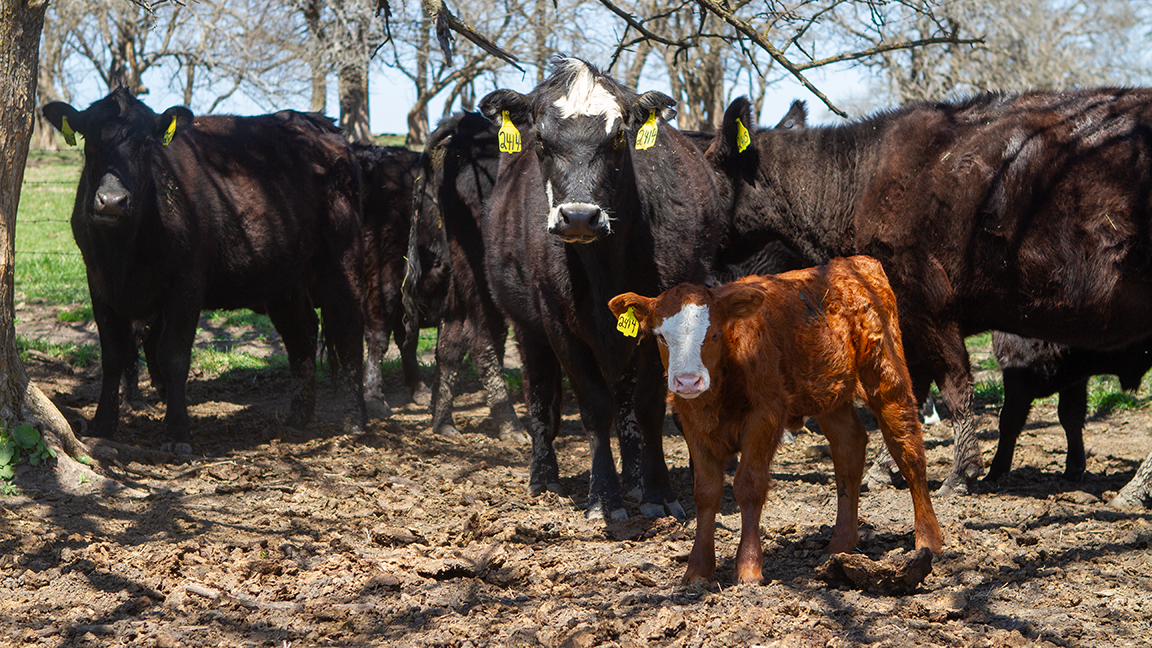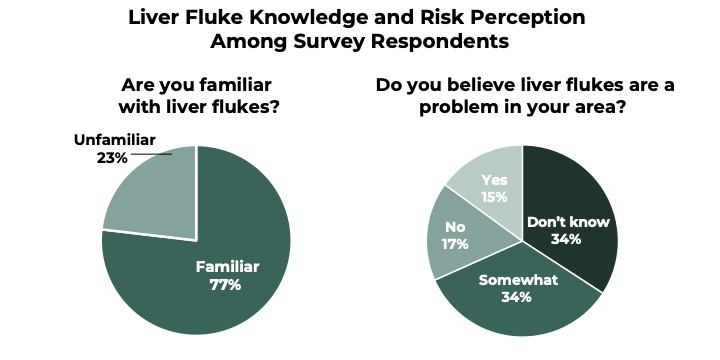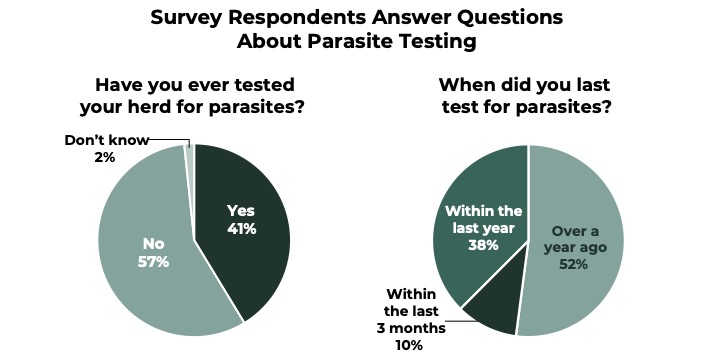Producer Survey Offers Insights Into Liver Fluke and Parasite Management
A survey of 120 cattle producers and veterinarians shows their management priorities when tackling liver flukes and other parasites.
May 20, 2025

by Boehringer Ingelheim
In a survey, 120 U.S. cattle producers and veterinarians were asked the following questions about liver flukes and parasite management:
- What is your familiarity with liver flukes?
- What impact do you see liver flukes having on your operation?
- What are your current practices for parasite diagnostic testing and treatment?
Although many respondents were familiar with liver flukes, results show a gap between knowledge and active management, leaving cattle operations at risk of the damaging fluke.
After analyzing the survey results, Jody Wade, veterinarian for Boehringer Ingelheim, offers actionable insights to help cattle caretakers address liver flukes and build sustainable, well-rounded deworming protocols.
Diagnostic testing is key for liver fluke awareness
In the survey, 77% of respondents said they were familiar with liver flukes. However, awareness did not directly translate into regional knowledge. Approximately 34% of respondents indicated they didn’t know if liver flukes were a problem in their area, while another 34% said liver flukes were “somewhat” of a problem.

Fig. 1: Most respondents were familiar with liver flukes, but only 15% believed flukes were a problem in their area.
Wade underscores the importance of diagnostic testing to confirm liver fluke presence, which often goes unnoticed.
“We’re finding flukes in regions we never thought they would be.” — Jody Wade
“We’re finding flukes in regions we never thought they would be,” he observes “Unless you’re taking fecal egg counts and actually looking for liver flukes as a cow-calf operator or a stocker, you’re not going to find them.”
Diagnostic testing in regions like Kansas and Tennessee has confirmed the presence of liver flukes, challenging the misconception that liver flukes are confined to the Gulf Coast or Pacific Northwest states.
Routine testing isn’t just crucial for fluke control; it’s important for sustainable management of all internal parasites. About 57% of survey respondents indicated they had never tested their herds for parasites. Out of those respondents that had tested, 52% said their last test was more than a year ago.

Fig. 2: The majority of survey respondents have never tested their herd for parasites, while most respondents said it has been more than a year since they last tested.
“Not a lot of producers are routinely testing, because it can be a time burden,” says Wade. “I still encourage producers to do it, because once we do, we have a really good snapshot of what is happening on the operation, which allows us to create the most strategic deworming plan.”
When producers send fecal samples for diagnostic testing, he reminds them to specify their desire for liver fluke analysis. A general diagnostic test will only look for common gastrointestinal parasites.
Liver flukes are worth consideration
While liver flukes rarely result in cattle death losses, understanding their underlying effects is important for cattle health and an operation’s bottom line.
“The biggest problem with flukes is their impact on production.” — Jody Wade
“The biggest problem with flukes is their impact on production,” says Wade. Liver flukes are one of the more complex parasites in beef production. Before setting up camp in the bile ducts of the liver, juvenile flukes cause damage in the small intestine and abdominal cavity as they travel, leaving cattle with weakened immune systems and lost growth potential.
Cattle with liver fluke infestations may go months without showing clinical signs. Depending on the level of infestation, cattle can experience loss of appetite, rough hair coat, decreased performance, weight loss and poor reproductive efficiency.1
“The ones that really pay for it on the back end are the packers,” Wade continues. “When they start harvesting cattle and find flukes, they have to condemn those livers.” Liver condemnations can lead to significant financial losses, particularly for feedlots and processors.
Liver flukes require special management
The survey highlighted common deworming practices among respondents, with pour-on and injectable dewormers being the most popular application methods. However, one-third of respondents said they were unsure if their dewormers include fluke coverage.
“Right now, there are only two products in the marketplace available for effective fluke management,” says Wade. “When selecting a product for liver fluke control, it’s important to look for a product that has clorsulon or is specifically labeled for fluke coverage.”
He further explains that the available products are only effective against adult stages and do not kill juvenile flukes, which cause the most damage. But, when applied correctly, the elimination of adult flukes can disrupt the production cycle and reduce the risk of pasture reinfestation.
Understanding the life cycle of liver flukes, from egg to adult, is essential for implementing effective control measures. Unlike other internal parasites, flukes need an intermediate host to propagate. For flukes, this is a common freshwater snail. As shown in Fig. 3, the fluke larvae migrate to snails, where they multiply. Once they exit the snail, cattle can ingest them by grazing on infested grass or drinking infested water.
While it isn’t realistic to keep cattle away from areas that also attract freshwater snails, sustainable deworming practices like pasture rotation and refugia (the practice of only deworming high-risk animals), are also ways to help control liver flukes and other parasite populations.

Fig. 3: The liver fluke’s full life cycle can take five or more months, making it difficult to detect prior to causing damage in cattle.
“Effective fluking really comes down to timing,” says Wade. “In the southeastern part of the country, like in Louisiana, Alabama and Mississippi, September is probably the best time to deworm for those liver flukes. In the Pacific Northwest, it’s a different deal. Most parasitologists will tell you to deworm between March and May, because it’s a later liver fluke season in that region.”
Liver fluke information is in demand
When asked about their interest in learning more about liver flukes, 72% of respondents said “yes.” In alignment, Wade says education is key to closing the gap between awareness and action.
By adopting evidence-based practices, cattle caretakers can protect their herds, improve production outcomes, and reduce the hidden costs of liver flukes. If flukes have been previously found in your area, Wade recommends getting a baseline for the herd through diagnostic testing. Only then can a sustainable, strategic deworming program be built through collaboration with a herd veterinarian.
Editor’s note: This article is provided by Boehringer Ingelheim. [Lead photo by Leann Schleicher.]
1USDA, National Agricultural Library. Liver flukes. Available online here. Accessed Jan. 22, 2025.
Angus Beef Bulletin EXTRA, Vol. 17, No. 5-B
Topics: Health , Management
Publication: Angus Beef Bulletin


